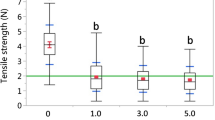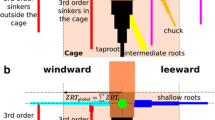Abstract
Red mangrove (Rhizhophora mangle L.) is the dominant tree species in the intertidal zone of ecosystems on the Atlantic shores of the Caribbean and tropical western Atlantic. The propagules of this species are initially buoyant, becoming negatively buoyant before rooting in a variety of substrates. After establishment, these seedlings form aerial roots, leading to communities of plants with complex networks of stems and aerial roots. While established mangrove communities assist in stabilizing coastlines, seedlings are susceptible to wave, current and wind energy and this limits the habitats that they can successfully colonize. In this experiment, the mechanical resistance of seedlings growing at five locations with different substrate and canopy conditions was tested. The 78 seedlings tested ranged in height from 27 to 47 cm, had between one and ten pairs of leaves but had not yet formed aerial roots. Seedlings were pulled horizontally. The reaction force at 20° deflection in four cardinal directions and then force to failure in the landward direction was measured. Seventy-five percent of the seedlings failed in the root system. The remainder failed near the base of the stem. Larger seedlings were more likely to fail at the roots. Seedlings growing outside of mangrove overstory on coral rubble were 3.5 times more strongly anchored than those growing within the mangrove overstory on sand. In spite of directional loading by waves and on-shore breezes, the deflection resistance did not vary systematically with pulling direction. Seedling anchorage varies among locations with different overstory and substrate conditions, likely due to differences in competition and acclimation to wind and wave energy along with differences in rooting among substrates.







Similar content being viewed by others
References
Banus MD, Kolehmaimen SE (1975) Floating, rooting and growth of red mangrove (Rhizophora mangle L.) seedlings: effect on expansion of mangroves in southwestern Puerto Rico. In: Walsh GE, Snedaker SC, Teas HJ (eds) Proceedings of international symposium on biology and management of mangroves. University of Florida, Florida, pp 370–384
Bowman HHM (1917) Ecology and physiology of the red mangrove. Proc Amer Phil Soc 56:589–672
Cahoon DR, Hensel P, Rybczyk J, McKee KL, Proffitt CE, Perez BC (2003) Mass tree mortality leads to mangrove peat collapse at Bay Islands, Honduras after Hurricane Mitch. J Ecol 91:1093–1105
Davis JH (1940) The ecology and geologic role of mangroves in Florida. Pap Tortugas Lab Carnegie Inst Washington 32:303–412
Denny M, Gaylord B (2002) The mechanics of wave-swept algae. J Exp Biol 205:1355–1362
Doyle TW, Girod G (1997) Ch. 7. The frequency and intensity of Atlantic hurricanes and their influence on the structure of south Florida mangrove communities. In: Diaz H, Pulwarty R (eds) Hurricanes, climatic change and socioeconomic impacts: a current perspective. Westview Press, New York, pp 111–128
Field A (2000) Discovering statistics using SPSS for Windows. Sage Publications, London
Gill AM, Tomlinson PB (1969) Studies on the growth of red mangrove (Rhizophora mangle) Part 1 habit and general morphology. Biotropica 1:1–9
Gopinath G (2009) Determination of sediment characteristics through cone penetration test in shallow marine areas using electrical compression cones. Curr Sci 96:206–208
Gourlay MR (1988) Coral cays: products of wave action and geological processes in a biogenic environment. In: Choat JH, Barnes D, Borowitzka MA, Coll JC, Davies PJ, Flood P, Hatcher BG, Hopley D, Hutchings PA, Kinsey D, Orme GR, Pichon M, Sale PF, Sammarco P, Wallace CC, Wilkinson C, Wolanski E, Bellwood O (eds) Proceedings of the 6th international coral reef symposium, vol 2, Townsville, pp 491–496
Hartstein N, Dickinson W (2006) Wave energy and clast transport in eastern Tasman Bay, New Zealand. Earth Surf Proc Land 31:703–714
Johnson ME, Watson C Jr (1999) Hurricane return period estimation. 10th symposium on global change studies, Dallas, pp 478–479
Lugo A (1980) Mangrove ecosystems: successional or steady-state. Biotropica 12:65–72
Mazda Y, Magi M, Ikeda Y, Kurokawa T, Asano T (2006) Wave reduction in a mangrove forest dominated by Sonneratia sp. Wetl Ecol Manag 14:365–378
Mitchell SJ (2003) Effects of mechanical stimulus, shade, and nitrogen fertilization on morphology and bending resistance in Douglas-fir seedlings. Can J For Res-Revue Canadienne De Recherche Forestiere 33:1602–1609
Nicoll BC, Dunn AJ (2000) The effects of wind speed and direction on radial growth of structural roots. In: Stokes A (ed) The supporting roots of trees and woody plants: form, function and physiology. Kluwer Academic Publishers, Netherlands, pp 219–225
Nicoll BC, Ray D (1996) Adaptive growth of tree root systems in response to wind action and site conditions. Tree Physiol 16:891–898
Nicoll BC, Gardiner BA, Rayner B, Peace AJ (2006) Anchorage of coniferous trees in relation to species, soil type, and rooting depth. Can J For Res 36:1871–1883
Niklas KJ (1992) Plant biomechanics: an engineering approach to plant form and function. The University of Chicago Press, Chicago
Oak HL (1984) The Boulder Beach: a fundamentally distinct sedimentary assemblage. Ann Assoc Am Geogr 74:71–82
Oliver CD, Larson BC (1996) Forest stand dynamics. John Wiley and Sons, New York
Piou C, Feller IC, Berger U, Chi F (2006) Zonation patterns of Belizean offshore mangrove forests 41 years after a catastrophic hurricane. Biotropica 38:365–374
Roth LC (1992) Hurricanes and mangrove regeneration: effects of hurricane Joan, October 1988, on the vegetation of Isla del Venado, Bluefields, Nicaragua. Biotropica 24:375–384
Sousa WP, Kennedy PG, Mitchell BJ, Ordóñez LBM (2007) Supply-side ecology in mangroves: do propagule dispersal and seedling establishment explain forest structure? Ecol Monogr 77:53–76
Stoddart DR (1963) Effects of hurricane Hattie on the British Honduras reefs, cays, October 30–31, 1961. Atoll Res Bull 95:142
Stokes A, Fitter AH, Coutts MP (1995) Responses of young trees to wind and shading: effects on root architecture. J Exp Bot 46:1139–1146
Tanaka N, Sasaki Y, Mowjood M, Jinadasa K, Homchuen S (2007) Coastal vegetation structures and their functions in tsunami protection: experience of the recent Indian Ocean tsunami. Landscape Ecol Eng 3:33–45
Telewski FW (1995) Wind-induced physiological and developmental responses in trees. In: Coutts MP, Grace J (eds) Wind and trees. Cambridge University Press, Cambridge, pp 237–263
Thom BG (1967) Mangrove ecology and deltaic geomorphology: Tabasco, Mexico. J Ecol 55:301–343
Tomlinson PB (1986) The botany of mangroves. Cambridge University Press, New York
Tomlinson PB, Cox PA (2000) Systematic and functional anatomy of seedlings in mangrove Rhizophoraceae: Vivipary explained? Bot J Linn Soc 134:215–231
UNEP-WCMC (2006) In the front line: shoreline protection and other ecosystem services from mangroves and coral reefs. UNEP-WCMC, Cambridge
Wade JE, Hewson EW (1979) Trees as a local climatic wind indicator. J Appl Meteorol 18:1182–1187
Waring RH, Schlesinger WH (1985) Forest ecosystems: concepts and management. Academic Press, Orlando
Acknowledgments
This research was funded in part by the Natural Sciences and Engineering research Council of Canada. The assistance of the staff at the Calabash Caye Institute of Marine Studies of the University of Belize and that of Mr. Tino Chi was greatly appreciated. Special thanks to Mr. Yalmar Kee for his help in the field.
Conflict of interest
The authors declare that they have no conflict of interest.
Author information
Authors and Affiliations
Corresponding author
Additional information
Communicated by T. Fourcaud.
Rights and permissions
About this article
Cite this article
Boizard, S.D., Mitchell, S.J. Resistance of red mangrove (Rhizophora mangle L.) seedlings to deflection and extraction. Trees 25, 371–381 (2011). https://doi.org/10.1007/s00468-010-0512-z
Received:
Revised:
Accepted:
Published:
Issue Date:
DOI: https://doi.org/10.1007/s00468-010-0512-z




